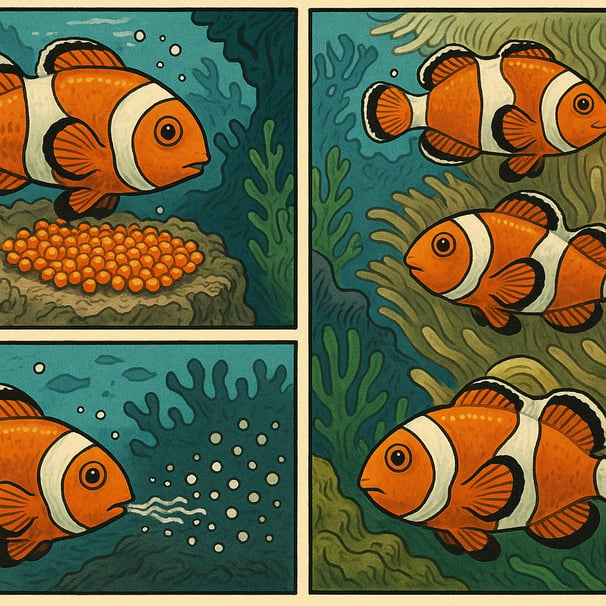The Fish That Changes Sex
Discover the bluehead wrasse, a real fish that can change from female to male in days. Learn how and why nature built this mind-blowing biological ability.
WEIRD ANIMALS
driver
5/26/20253 min read


🐟 The Fish That Changes Sex—And Controls Its Own Population
Deep in coral reefs, a strange biological trick unfolds every day.
A male becomes female.
A female becomes male.
No surgery. No hormones. No choice.
This is not science fiction or genetic engineering. It’s just another day in the life of the bluehead wrasse, a small but mighty fish that challenges everything we think we know about sex, identity, and evolution.
In a world obsessed with rigid biological roles, this tropical fish throws it all out the window—and survives by rewriting its own biology.
Let’s dive into the strange, real-life world of sex-changing fish—and what they can teach us about nature’s incredible adaptability.
🐠 Meet the Bluehead Wrasse
The bluehead wrasse (Thalassoma bifasciatum) is a brightly colored fish found in the warm waters of the Caribbean Sea.
They live in coral reef communities, forming tightly structured social groups with one dominant male, several females, and a few subordinate males waiting in the wings.
The dominant male has the classic bold blue head and guards his harem fiercely.
But when that male disappears or dies?
Everything changes.
♻️ Nature’s Most Dramatic Identity Shift
If the dominant male is removed, something strange happens within minutes.
The largest female in the group begins transforming into a male.
This isn’t behavioral—it’s biological:
Her hormone levels begin to shift
Her ovaries regress and testes begin to form
Her coloration changes
She adopts the male’s territorial and mating behavior
Within days, she becomes fully male, both in function and form
This process is called protogynous hermaphroditism—"proto" (first), "gynous" (female). The fish starts life as a female and can switch to male if needed.
It’s not rare. In fact, over 500 species of fish are capable of this transformation.
But the bluehead wrasse does it faster and more completely than almost any other.
🧠 How Does the Brain Know When to Switch?
Scientists have found that the transformation is triggered not just by biology, but by social environment.
The female recognizes that the dominant male is gone. She may observe behavior or notice changes in pheromones or even territorial signals.
This social cue activates the brain’s hypothalamus, which rapidly changes its output of gonadotropin-releasing hormone (GnRH)—a key player in sexual development.
From brain to body, a cascade of hormonal events begins.
Within 20 minutes, behavior shifts.
Within 24 hours, the gonads begin to transform.
In 10 days? New fish, new role, new identity.
🔬 Can Males Become Female Too?
Yes—but it’s less common and slower.
In species like clownfish, the reverse is true: the dominant individual is female, and if she dies, the largest male transforms into a female to take over the reproductive role.
This is called protandrous hermaphroditism—male first.
It’s the exact setup you saw in Finding Nemo, by the way—except Disney skipped the part where Nemo’s dad would have turned into his mom. (Yeah. Awkward.)
🌍 Why Evolve This Way?
Changing sex might sound extreme, but it’s evolutionally genius.
In environments with imbalanced sex ratios or strong social hierarchies, being able to switch roles increases reproductive success.
For example:
A female wrasse might never get a chance to breed if she remains in the background. But once the male dies, her promotion ensures the group survives.
For clownfish, larger individuals make better females because egg production is energy-intensive—so size equals fertility.
Flexibility equals survival. Nature loves options.
🧬 Can Humans Do This?
Not like fish.
While humans can change secondary sexual characteristics through hormone therapy and surgery, we can’t spontaneously shift from one reproductive system to another.
But what’s fascinating is that many of the genes and hormones that drive sex determination in fish exist in humans too—like estrogen, testosterone, and aromatase enzymes.
It’s just that our wiring is locked in after birth.
Fish? Not so much.
⚠️ Environmental Threats to Sex-Switching Fish
Here’s the twist: these incredible biological systems are highly sensitive to environmental changes.
Endocrine-disrupting chemicals (found in plastics and pesticides) can interfere with sex determination
Rising ocean temperatures may skew sex ratios
Overfishing can remove dominant males, destabilizing group structures
In other words: the same ability that gives these fish their edge also makes them vulnerable in a polluted, warming ocean.
🧠 Final Thought: Fluid Biology, Solid Science
The bluehead wrasse and its sex-changing cousins challenge our understanding of identity, biology, and nature itself.
In a world where we expect life to fit tidy boxes, these fish show us that evolution thrives on fluidity.
Their bodies shift. Their roles change.
And they survive — because they’re built to adapt.
Nature didn’t ask what “should” be.
It asked: what works?
And the answer is weird, wild, and wonderfully real.
📚 Sources / References:
Warner, R. R. – Sex Change and the Size-Advantage Model in Marine Fishes, Annual Review of Ecology
Godwin, J. – Neuroendocrinology of Social Regulation in Sex-Changing Fish, Integrative and Comparative Biology
Coral Reef Fish Biology, Oxford University Press
National Geographic – When Fish Change Sex: A Marine Survival Strategy
Science Advances – Rapid Sex Reversal in the Bluehead Wrasse
